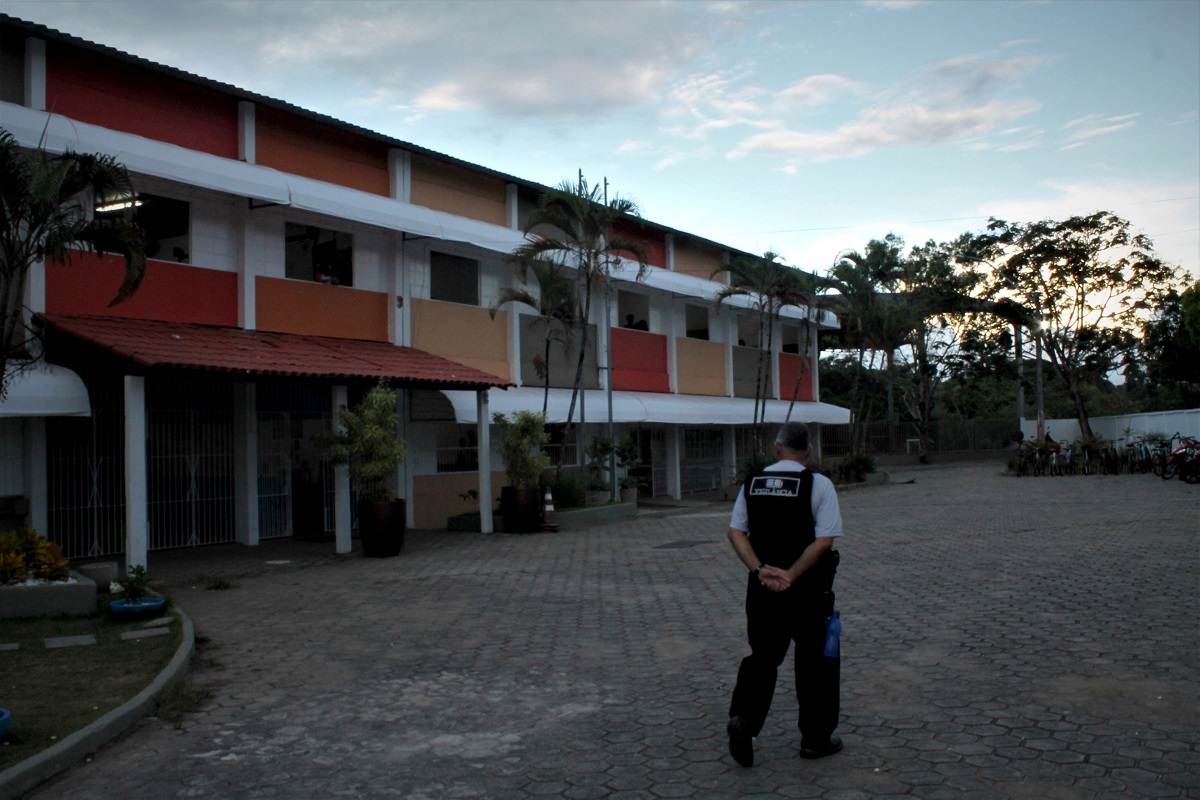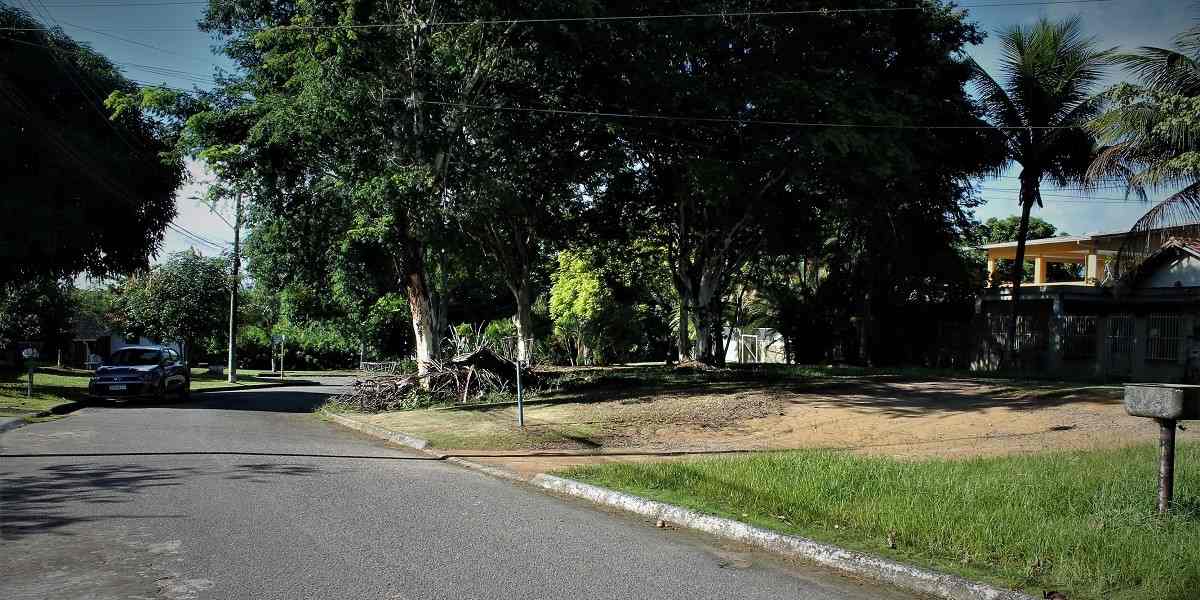
A security guard patrols Primo Bitti, the state school in Aracruz where the 16-year-old former student shot three people to death and wounded eight more.
11:43 JST, April 13, 2023
ARACRUZ, Brazil – The 16-year-old waited until his father left the house before executing his plan. Then he pulled on his camouflage fatigues, wrapped a swastika around his arm, grabbed a mask painted with a skull and retrieved his father’s guns – the Taurus .40-caliber and the .380-caliber revolver.
Heading out into Aracruz that late November morning, this was his intent: to kill as many people as possible.
What authorities say came next will be painfully familiar to any American. The boy drove to two schools, where he shot four people to death, wounded 10 more and delivered to this coastal city of 100,000 the kind of anguish that has devastated American communities from Newtown, Conn., to Uvalde, Tex.
For decades, school massacres have seemed a distinctly American disease. But now Brazil is infected, too.
In the past four years, Latin America’s largest nation has suffered 17 school attacks. Twenty-six people have been killed and dozens wounded. In the last eight months alone, the country has endured 11 assaults, alarming many Brazilians who now fear that the carnage is just beginning.
Many of the perpetrators fit a profile Americans will recognize: young, disaffected White men and boys in the grip of online groups that worship the killers of schoolchildren. Some have adopted the iconography of hate groups based in the United States: the skull masks of the white supremacist Atomwaffen Division, swastikas and other hate symbols. Several, including the boy in Aracruz, were inspired by the 1999 Columbine massacre in Colorado.
In the debate over whether the abundance of guns in American life is leading to increasingly deadly school attacks, the Brazilian assaults offer a unique, if tragic, case study.
The two sprawling countries are in many ways similar: bound by a shared history of colonialism and slavery, and characterized today by political polarization, racial strife, economic stagnation and social media obsession.
But one difference divides them.
“Access to guns,” said Daniel Cara, an education researcher at the University of São Paulo. “We have the social climate. We have a community that is mobilized. The only thing missing is access to guns.” In a country where firearms are far more difficult to obtain than in the United States, more than half of the recent school attacks have been committed with knives, machetes or, this month, a hatchet.
The result has been substantially fewer deaths. More than half of the attacks in the past year didn’t result in a single death.
In one representative incident late last month, police say, a 13-year-old student in São Paulo excused himself to go to the bathroom. He returned wearing the skull mask and holding a long knife. He then allegedly stabbed to death his teacher, 71, and wounded five others.
Afterward, authorities say, he told investigators he had tried to purchase a gun online but failed. In a social media posting the night before, he lamented committing his attack “without a decent weapon.”
He had wanted to be like the boy in Aracruz, whose dress he mimicked. He wanted to kill more people.
The global appeal of Columbine
Researchers have long studied what they call the Columbine effect – the enduring fascination with Eric Harris and Dylan Klebold, the students who shot 13 people to death in their Colorado high school. In the words of sociologist Ralph Larkin, they wrote the “cultural script” that continues to inspire shooters in the United States and abroad.
In France, a teenager allegedly shot eight people at his high school in 2017 after watching videos of the Columbine massacre. In Britain, two teens who reportedly idolized the Columbine duo were charged that year with plotting a school massacre. In Russia last year, police say, a man killed 17 students at his former school with guns braided with cords that spelled out “Columbine” and the names “Eric” and “Dylan.”
The Columbine effect has hit Brazil particularly hard. Investigators and researchers here have uncovered an active ecosystem online of hundreds, if not thousands, of users paying homage to school massacres while peddling antisemitism and racism. They trade images, videos and memes of the Columbine shooters, referring to them by their own online handles, “Reb” and “VoDKa.”
Researchers at the State University of Campinas in São Paulo have discovered many online groups. “Trench Coat Mafia 2.0,” one calls itself on Discord, in reference to a student clique at Columbine, and boasts of being “the biggest Brazilian server about criminal cases, principally involving school shootings and killings.” The university’s library was vandalized in 2018, in apparent retaliation for the researchers’ work. One message the vandals left: “There’s going to be a #columbine massacre.”
The next year, a teen named Guilherme Taucci Monteiro, 17, obtained a .38 revolver illegally and with partner Luiz Henrique de Castro, 25, attacked a school in the São Paulo suburb of Suzano in imitation of the Columbine massacre. Ten people died, including the shooters, who died by suicide.
Today, the Suzano shooting is lauded online. Brazilians who celebrate school killings use Taucci’s skull mask in their profile pictures. Others, like the 13-year-old who stabbed his teacher to death, dub themselves “Taucci” in their screen names. Users say they will wear the same symbols in their own massacres.
“Do you know where they sell this mask?” one person asked last week. Their profile read: “THE BULLYING ONLY STOPS WHEN YOU SHOOT.” (The post has since been deleted.)
“Don’t do what happened in 2019 in Suzano,” one person pleaded. “They’re not heroes.”
“I DO WHAT I WANT,” came the response.
A carefully planned attack
One boy who studied the violence lived in a yellow house on a quiet street in Aracruz. To neighbors, his family appeared the picture of suburban stability. His father, a police officer, was president of the neighborhood association. His mother was a recently retired schoolteacher. But for two years, inside the yellow house, the teenage boy quietly analyzed school massacres – and planned his own.
“The Columbine and Suzano attacks interested him greatly,” Aracruz police detective André Jaretta said. “He read about them. He learned the stories of the perpetrators. They were an inspiration to him.”
The Washington Post is not naming the boy because he is a minor.
The boy’s parents did not respond to requests for comment. But in testimony given to police, Fábio Cunha Castiglioni, his father, described him as a very happy baby, always smiling, who retreated into himself as he got older, growing increasingly serious and quiet – even “rigid.”
The father thought it was strange for a boy to be so gloomy, he told investigators, so the family sought psychological care and took him on vacations. But nothing seemed to lighten his demeanor.
When he was around 13, his father said, he started to complain he was being bullied at school. It was a “watershed” moment, when the happy baby he once knew disappeared for good, and he withdrew still further.
On the rare instances neighbors saw him outside the house, he was alone or with a parent. Never with friends.
Even online, Jaretta said, he didn’t interact with others. Instead, the detective said, he read and “absorbed.” He consumed videos that “teach, incentivize and justify school attacks,” police say in a case filing.
On the morning of Nov. 25, armed with his father’s guns, he drove to Primo Bitti, the state school where his mother, Maria Aparecida Rodrigues Castiglioni, had worked. He entered the building from the back, near a teachers’ lounge. It was packed with faculty.
He went in shooting, stopping only once to reload his Taurus .380. Within a minute, he had killed three teachers and wounded eight more. Then he drove to a private school and pulled out the revolver. He killed Selena Zagrillo, 12, and wounded two others.
The boy was arrested and confessed later that day, authorities say. A judge within two weeks sentenced him to three years of institutional confinement – the maximum penalty for a minor in Brazil.
Selena’s mother, looking down at her hands months later, shook her head and smiled bitterly. Her daughter had lost her life. Her killer will only lose three years. He’ll even escape the stain of having his name publicized.
“How could someone like him be allowed to come back into society?” Thais Fanttini asked. “I don’t even get a sense of justice.”

The suburban street in Aracruz where the 16-year-old killer lived.
Memories of a massacre
Three teachers sat inside the new lounge at Primo Bitti school last week, whispering about another attack. Just that morning, a man had broken into a day-care center in Santa Catarina state. He killed four children between the ages of 4 and 7 with a hatchet.
This new violence had erupted place 900 miles to the south. But to the teachers, it felt much closer.
One closed her eyes. She had been in the room when her colleagues were killed, she said.
The woman, who spoke on the condition of anonymity because she wasn’t authorized to speak publicly, had hidden underneath a long desk and tried to stay quiet. Months later, she said, she still can’t stop seeing the killer’s boots as he walked past.
“This has messed with all of us so much,” she said.
Government officials and schools across the country are considering new safety measures. Some have called for American solutions: metal detectors, armed guards and active shooter drills. Other say such measures will do more harm terrifying children than good stopping an actual attack.
Brazil’s federal government has asked Twitter to block hundreds of accounts that circulate violent rhetoric and unveiled a tip line to identify potential assailants.
None of that has made the Aracruz teachers feel safer. They said another attack was coming, somewhere in this country that to them seemed in this new way every day more like the United States.
“In five years,” one said, “this will be so much worse.”
"News Services" POPULAR ARTICLE
-

American Playwright Jeremy O. Harris Arrested in Japan on Alleged Drug Smuggling
-

Japan’s Nikkei Stock Average as JGB Yields, Yen Rise on Rate-Hike Bets
-

Japan’s Nikkei Stock Average Licks Wounds after Selloff Sparked by BOJ Hike Bets (UPDATE 1)
-

Japan’s Nikkei Stock Average Buoyed by Stable Yen; SoftBank’s Slide Caps Gains (UPDATE 1)
-

Japanese Bond Yields Zoom, Stocks Slide as Rate Hike Looms
JN ACCESS RANKING
-

Keidanren Chairman Yoshinobu Tsutsui Visits Kashiwazaki-Kariwa Nuclear Power Plant; Inspects New Emergency Safety System
-

Imports of Rare Earths from China Facing Delays, May Be Caused by Deterioration of Japan-China Relations
-

Tokyo Economic Security Forum to Hold Inaugural Meeting Amid Tense Global Environment
-

University of Tokyo Professor Discusses Japanese Economic Security in Interview Ahead of Forum
-

Japan Pulls out of Vietnam Nuclear Project, Complicating Hanoi’s Power Plans






















